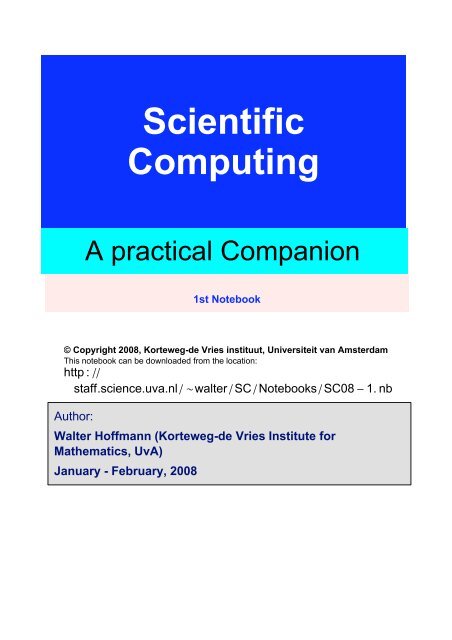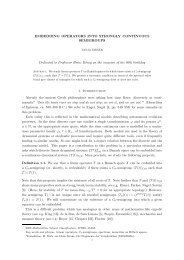Scientific Computing - Universiteit van Amsterdam
Scientific Computing - Universiteit van Amsterdam
Scientific Computing - Universiteit van Amsterdam
Create successful ePaper yourself
Turn your PDF publications into a flip-book with our unique Google optimized e-Paper software.
<strong>Scientific</strong><br />
<strong>Computing</strong><br />
A practical Companion<br />
1st Notebook<br />
© Copyright 2008, Korteweg-de Vries instituut, <strong>Universiteit</strong> <strong>van</strong> <strong>Amsterdam</strong><br />
This notebook can be downloaded from the location:<br />
http : êê<br />
staff.science.uva.nlê ~walter ê SC ê Notebooksê SC08 - 1. nb<br />
Author:<br />
Walter Hoffmann (Korteweg-de Vries Institute for<br />
Mathematics, UvA)<br />
January - February, 2008
2 SC08-1.nb<br />
Outline of this course<br />
Introduction<br />
The most ad<strong>van</strong>ced computer<br />
platform becomes<br />
WORTHLESS when a BAD<br />
ALGORITHM is used.<br />
We concentrate on solving problems that are stated as (large scale) Differential Equations.<br />
Type of Problems:<br />
I) Ordinary Differential Equations ( ODE's )<br />
(One independent variable; in general time, position (place))<br />
IA) Initial Value Problems (IVP's)<br />
IB) Boundary Value problems (BVP's)<br />
II) Partial Differential Equations ( PDE's)<br />
(Two or more independent variables; in general time and position )<br />
IIA) Elliptic Problems (Diffusion;<br />
Laplace * equation: u xx + u yy = 0<br />
Poisson ** equation: u xx + u yy = fHx, yL<br />
)<br />
IIB) Parabolic Problems (Heat equation: u t = k u xx )<br />
IIC) Hyperbolic Problems ( Wave equation: u tt = c 2 u xx )
SC08-1.nb 3<br />
*L Pierre-Simon Laplace 1749 - 1827<br />
**L Simeon Poisson 1781 - 1840<br />
Solution methods<br />
either explicit or implicit<br />
Representation of the Solution:<br />
Solution as linear combination of basis functions; leads to<br />
- Finite Element Method (FEM);<br />
- Finite Volume Method<br />
Solution calculated in finitely many points that are chosen on a grid;<br />
interpolation methods necessary to calculate solution in intermediate points.<br />
- Finite Difference method (method of choice during lab-work in<br />
this course)<br />
Class is combination of "PUSH" and<br />
"PULL":<br />
PUSH: What every graduate student in <strong>Scientific</strong> <strong>Computing</strong> should<br />
know about solving ODE's and PDE's<br />
PULL: What has to be explained from<br />
the concepts that are used in lab-work
4 SC08-1.nb<br />
Basic Tools<br />
Mean Value Theorem (MVT):<br />
Let f be a function that is continuous and differentiable on [a,b].<br />
Then there exists a point x œ [a,b] such that<br />
or analogously:<br />
f HbL - f HaL<br />
ÅÅÅÅÅÅÅÅÅÅÅÅÅÅÅÅ ÅÅÅÅÅÅÅÅÅÅÅÅÅÅÅÅÅ Å<br />
b - a<br />
= f ' HxL ,<br />
f Hx + hL - f HxL<br />
ÅÅÅÅÅÅÅÅÅÅÅÅÅÅÅÅÅÅÅÅÅÅÅÅÅÅÅÅÅÅÅÅ ÅÅÅÅÅÅÅÅÅÅÅÅÅÅ = f ' Hx + qhL; 0 § q § 1 .<br />
h<br />
Attractive versus Repulsive Fixed-point:<br />
Let g:D Ø D be a given function;<br />
the row 8R n< = {x 0 , x 1 , x 2 , .... , x n } is defined by<br />
Any value (argument, result) s with<br />
x k+1 = g Hx k L, for given x 0 .<br />
s = g HsL<br />
is called a fixed-point of the iteration xk+1 = g HxkL<br />
(''what goes in comes out'')<br />
Convergence:<br />
For any choice x0 that is sufficiently close to s, the row R n may or may not converge to s, depending on<br />
the derivative g'(s).<br />
For a given row R n to converge to s, we ultimately require:
SC08-1.nb 5<br />
From the definitions and MVT we have:<br />
xn+1 - s<br />
ÅÅÅÅÅÅÅÅÅÅÅÅÅÅÅÅ ÅÅÅÅÅÅÅÅÅÅÅ<br />
ƒ xn - s ƒ<br />
< 1<br />
xn+1 - s<br />
ÅÅÅÅÅÅÅÅÅÅÅÅÅÅÅÅ ÅÅÅÅÅÅÅÅÅÅÅ<br />
ƒ xn - s ƒ =<br />
g HxnL - g HsL<br />
ÅÅÅÅÅÅÅÅÅÅÅÅÅÅÅÅ ÅÅÅÅÅÅÅÅÅÅÅÅÅÅÅÅ ÅÅÅÅÅÅÅÅ =<br />
ƒ xn - s ƒ<br />
» g' HxL »,<br />
x between xn and s .<br />
Convergence must (eventually) occur when »g'(s)» < 1,<br />
s is called an attractive fixed-point.<br />
Whenever »g'(s)» > 1, convergence is not possible; s is called a repulsive fixed-point.<br />
For the case »g'(s)» = 1, no general statement is applicable.<br />
Taylor Series Expansion (Taylor):<br />
The following is known as Taylor's *L theorem.<br />
Let f be a function that is continuous on [a,b] such that the derivatives of f of order up to and<br />
including n are defined and continuous on [a,b]then for each x œ [a,b] there exists a q = q(x)<br />
with 0≤q≤1 such that<br />
f HxL = f HaL + Hx - aL f ' Ha L + 1<br />
ÅÅÅÅÅÅÅ Hx - aL<br />
2! 2 f '' HaL + 1<br />
ÅÅÅÅÅÅÅ Hx - aL<br />
3! 3 f ''' HaL + ...<br />
+ 1<br />
ÅÅÅÅÅÅÅ<br />
n! Hx - aL n f HnL Ha + q Hx - aLL; 0 § q § 1 .<br />
which, apart from the remainder term, is a power series in (x - a); the first "so many terms", form a<br />
polynomial in x .<br />
With names of the variables changed appropriately, the expansion can also be written as:<br />
f Hx + hL = f HxL + h f ' Hx L + 1<br />
ÅÅÅÅÅÅÅ h<br />
2 ! 2 f '' HxL + 1<br />
ÅÅÅÅÅÅÅ h<br />
3! 3 f ''' HxL + ...<br />
+ 1<br />
ÅÅÅÅÅÅÅ<br />
n! h n f HnL Hx + qhL; 0 § q § 1 .<br />
Observe that in this formula x is assumed to be constant and h is variable resulting in a power series in h for<br />
the first "so many" terms.<br />
The following well known series expansions are special cases of series expansions stemming from Taylor's<br />
theorem with the choice a=0;the resulting approximation of a function in the form of a powerseries is<br />
called a Maclaurin **L series:
6 SC08-1.nb<br />
exp HxL = 1 + x + 1<br />
ÅÅÅÅ x<br />
2 2 + 1<br />
ÅÅÅ Å x<br />
6 3 + ... ; Hfor all xL<br />
cos HxL = 1 - 1<br />
ÅÅÅ Å x<br />
2 2 + 1<br />
ÅÅÅÅÅÅÅ x<br />
4! 4 - 1<br />
ÅÅÅÅÅÅÅ x<br />
6! 6 + ... ; Hfor all xL<br />
sin HxL = x - 1<br />
ÅÅÅ Å x<br />
6 3 + 1<br />
ÅÅÅÅÅÅÅ x<br />
5! 5 + ... ; Hfor all xL<br />
ln H1 + xL = x - 1<br />
ÅÅÅÅ x<br />
2 2 + 1<br />
ÅÅÅ Å x<br />
3 3 - 1<br />
ÅÅÅÅ x<br />
4 4 + ... ; -1 < x § 1<br />
*) Brook Taylor 1685 - 1731<br />
**) Colin Maclaurin 1698 - 1746<br />
Solving differential equations I<br />
Visualization of Vectorfield<br />
Visualization of families of solutions of ODE's.<br />
We use the package VisualDSolve (developed at Amstel Institute, UvA) that can be downloaded from<br />
http://staff.science.uva.nl/~walter/SC/Notebooks/VisualDSolve.m<br />
Loading the package by<br />
In[1]:=<br />
SC08-1.nb 7<br />
In[3]:=<br />
Off@NDSolve::precwD<br />
An innocent looking ODE:<br />
x ' HtL = x HtL 2<br />
Draw its vectorfield for a finite interval [0, 2] for t and a symmetrical interval for the x-value:<br />
In[4]:=<br />
VisualDSolve@x'@tD == x@tD^2,<br />
8t, -2, 3
8 SC08-1.nb<br />
In[5]:=<br />
VisualDSolve@x'@tD == x@tD^2, 8t, -2, 3
SC08-1.nb 9<br />
In[6]:=<br />
VisualDSolve@x'@tD == 10 x@tD - 10 x@tD^2,<br />
8t, -2, 3
10 SC08-1.nb<br />
In[8]:=<br />
In[9]:=<br />
VisualDSolve@x'@tD == 10 x@tD - 10 x@tD^2,<br />
8t, -1, 2
SC08-1.nb 11<br />
In[10]:=<br />
VisualDSolve@x'@tD == 10 x@tD - 10 x@tD^2,<br />
8t, -1, 2
12 SC08-1.nb<br />
*L Leonhard Euler 1707 - 1783<br />
2<br />
xn+1 = xn + Dt I10 xn - 10 xn M = xn H1 + 10 Dt - 10 Dt xnL. For evaluating the required iterations, we use the Mathematica routines NestList and ListPlot.<br />
We set a = 10 Dt :<br />
In[11]:=<br />
IterFunction@a_D@x_D := x * H1 + a - a * xL;<br />
We use Forward Euler to get a numerical solution for the case x(0) = 0.1 .<br />
We try various values for the increment Dt ;<br />
a choice Dt= 0.08 leads to a = 0.8 giving<br />
In[12]:=<br />
In[13]:=<br />
g@x_D := IterFunction@0.8D@xD;<br />
NestList@g, 0.1, 20D<br />
ListPlot@%, PlotStyle -> PointSize@0.02DD;<br />
Out[13]=<br />
80.1, 0.172, 0.285933, 0.449273,<br />
0.647214, 0.829877, 0.942822, 0.985949,<br />
0.997032, 0.999399, 0.99988, 0.999976,<br />
0.999995, 0.999999, 1., 1., 1., 1., 1., 1., 1.<<br />
1<br />
0.8<br />
0.6<br />
0.4<br />
0.2<br />
5 10 15 20<br />
Larger values for the increment Dt lead to larger values for a as is shown:<br />
In[15]:=<br />
g@x_D := IterFunction@1.2D@xD;
SC08-1.nb 13<br />
In[16]:=<br />
NestList@g, 0.1, 20D<br />
ListPlot@%, PlotStyle -> PointSize@0.02DD;<br />
Out[16]=<br />
80.1, 0.208, 0.405683, 0.695008, 0.949374,<br />
1.00705, 0.99853, 1.00029, 0.999942, 1.00001,<br />
0.999998, 1., 1., 1., 1., 1., 1., 1., 1., 1., 1.<<br />
1<br />
0.8<br />
0.6<br />
0.4<br />
0.2<br />
The choice Dt = 0.2 leads to a = 2 giving:<br />
In[18]:=<br />
g@x_D := IterFunction@2.0D@xD;<br />
5 10 15 20
14 SC08-1.nb<br />
In[19]:=<br />
NestList@g, 0.1, 20D<br />
ListPlot@%, PlotStyle -> PointSize@0.02DD;<br />
Out[19]=<br />
80.1, 0.28, 0.6832, 1.11608, 0.856977, 1.10211,<br />
0.877035, 1.09272, 0.89008, 1.08576, 0.899537,<br />
1.08028, 0.906834, 1.07581, 0.9127, 1.07206,<br />
0.917558, 1.06885, 0.921671, 1.06606, 0.925215<<br />
1.1<br />
0.9<br />
0.8<br />
0.7<br />
0.6<br />
0.5<br />
5 10 15 20<br />
Experimenting with several choices for even larger values of Dt(and therefore a) leads to the following<br />
results:<br />
In[21]:=<br />
g@x_D := IterFunction@2.3D@xD;
SC08-1.nb 15<br />
In[22]:=<br />
NestList@g, 0.1, 20D<br />
ListPlot@%, PlotStyle -> PointSize@0.02DD;<br />
Out[22]=<br />
80.1, 0.307, 0.796327, 1.16936, 0.713852, 1.18367,<br />
0.683646, 1.18108, 0.689186, 1.18187, 0.687501,<br />
1.18164, 0.687982, 1.18171, 0.687842, 1.18169,<br />
0.687883, 1.18169, 0.687871, 1.18169, 0.687874<<br />
1.2<br />
1<br />
0.8<br />
0.6<br />
0.4<br />
0.2<br />
5 10 15 20<br />
Let us start with a value of x0 which is close to the limit value 1; this leads to:<br />
In[24]:=<br />
NestList@g, 1.000000001, 20D<br />
ListPlot@%, PlotStyle -> PointSize@0.02DD;<br />
Out[24]=<br />
81., 1., 1., 1., 1., 1., 1., 1., 1., 1.,<br />
1., 1., 1., 1., 1., 1., 1., 1., 1., 1., 1.<<br />
1<br />
1<br />
1<br />
1<br />
1<br />
1<br />
5 10 15 20
16 SC08-1.nb<br />
In[26]:=<br />
In[28]:=<br />
In[29]:=<br />
NestList@g, 1.000000001, 120D;<br />
ListPlot@%, PlotStyle -> PointSize@0.02DD;<br />
1.1<br />
0.9<br />
0.8<br />
0.7<br />
g@x_D := IterFunction@3D@xD;<br />
20 40 60 80 100 120<br />
NestList@g, 1.000000001, 100D;<br />
ListPlot@%, PlotStyle -> PointSize@0.02DD;<br />
1.2<br />
1<br />
0.8<br />
0.6<br />
0.4<br />
0.2<br />
20 40 60 80 100<br />
Close all sections

















